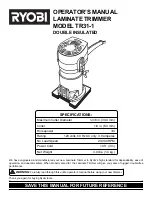
ENGLISH • 15
b. Use personal protective equipment. Always wear
eye protection. Protective equipment such as dust
mask, non-skid safety shoes, hard hat, or hearing
protection used for appropriate conditions will reduce
personal injuries.
c. Prevent unintentional starting. Ensure the switch
is in the off-position before connecting to power
source and/or battery pack, picking up or carrying
the tool. Carrying power tools with your finger on the
switch or energising power tools that have the switch
on invites accidents.
d. Remove any adjusting key or wrench before
turning the power tool on. A wrench or a key left
attached to a rotating part of the power tool may result
in personal injury.
e. Do not overreach. Keep proper footing and
balance at all times. This enables better control of
the power tool in unexpected situations.
f. Dress properly. Do not wear loose clothing or
jewellery. Keep your hair, clothing and gloves away
from moving parts. Loose clothes, jewellery or long
hair can be caught in moving parts.
g. If devices are provided for the connection of dust
extraction and collection facilities, ensure these are
connected and properly used. Use of these devices
can reduce dust related hazards.
4. Power tool use and care
a. Do not force the power tool. Use the correct power
tool for your application. The correct power tool will
do the job better and safer at the rate for which it was
designed.
b. Do not use the power tool if the switch does not
turn it on and off. Any power tool that cannot be
controlled with the switch is dangerous and must be
repaired.
c. Disconnect the plug from the power source and/or
the battery pack from the power tool before
making
any adjustments, changing accessories,
or storing power tools. Such preventive safety measures
reduce the risk of starting the power tool accidentally.
d. Store idle power tools out of the reach of children
and do not allow persons unfamiliar with the power
tool or these instructions to operate the power
tool.
Power tools are dangerous in the hands
of untrained users.
e. Maintain power tools. Check for misalignment
or binding of moving parts, breakage of parts and
any other condition that may affect the power
tools operation. If damaged, have the power tool
repaired before use. Many accidents are caused by
poorly maintained power tools.
f. Keep cutting tools sharp and clean. Properly
maintained cutting tools with sharp cutting edges are
less likely to bind and are easier to control.
5. Service
a. Have your power tool serviced by a qualified
repair person using only identical replacement
parts. This will ensure that the safety of the power
tool is maintained.
6. Electrical safety
AN IMPORTANT
CONSUMER FEATURE
Your tool is DOUBLE INSULATED to give you added
safety. This means that it is constructed throughout
with two separate “layers” of electrical insulation or one
double thickness of insulation between you and the tool’s
electrical system.
Note: DOUBLE INSULATION does not take the place of
normal safety precautions when operating this tool. The
insulation system is for added protection against injury
resulting from a possible electrical insulation failure within
the tool.resultante de fallas en el aislamiento eléctrico
interno de la herramienta.
Warning! If the power cord is damaged, it must
be replaced by the manufacturer, authorized
BLACK+DECKER Service Center or an equally
qualified person in order to avoid damage or
injury. If the power cord is replaced by an equally
qualified person, but not authorized by
BLACK+DECKER, the warranty will not be valid.
7. Labels on appliance
Read the manual prior to operation.
Wear safety glasses or goggles when operating this appliance
Wear suitable ear protectors when operating this appliance
Always remove the plug from the socket before inspecting a
damaged cable. Be careful not to use your strimmer if the
cable is damaged.
Beware of flying objects.
Keep bystanders away from the cutting area.
Do not expose the appliance to rain or high humidity.
Directive 2000/14/EC guaranteed sound power.








































